As president of Fargo, N.D.-based Sanford Health HealthCare Accessories, Russ Nylander is quick to acknowledge that his home medical equipment (HME) company can’t be all things to all people.
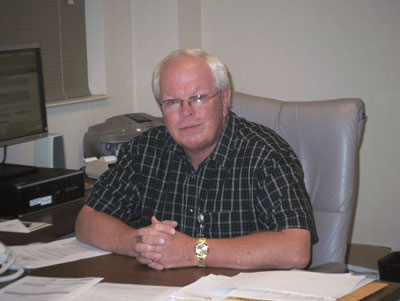
But something to everyone? Well, that’s another matter.
Sites, Selection
The broad-based HME company, which is part of the Sanford Health system, has seven locations and 160 employees serving the entire state of North Dakota, the northern half of Minnesota and northeastern South Dakota. It provides everything from oxygen, CPAP, aids for daily living and rehab technology to vehicle and home accessibility modifications and ostomy, incontinence and wound care products.
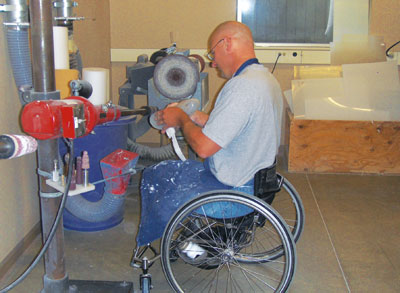
With a 6,500 square-foot showroom in Fargo, as well as other locations, it has something for everyone. But nearly a third of its business—30 percent, according to Nylander—is orthotics and prosthetics (O&P) along with orthopedic softgoods.
“You can go from a sleeve that would be a compression garment all the way to a fabricated device, whatever the need is,” he says, noting that the company provides basic orthopedic products such as ankle and knee braces, after-surgery boots and back supports as well as highly customized prosthetics made in its own fabrication department.
“By doing our own fabrication, we are able to control the quality aspect of the process and provide shorter turnaround time for our customers,” Nylander says, “although we do send a few projects, such as foot orthotics and spinal control orthoses, to be made at other labs.”
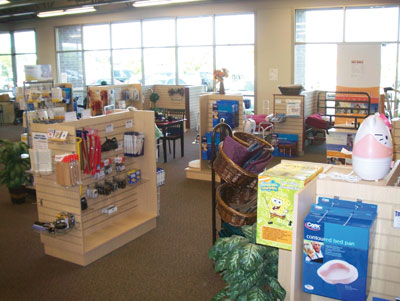
Quality is paramount to HealthCare Accessories. “Being accredited by both the Joint Commission and The American Board of Certification in Orthotics and Prosthetics allows us to meet some of the highest standards of practice in the industry. This assures our customers that quality, safety and meeting their needs are our top priority.
“Our philosophy for doing business is this: ‘Put the customer first,’” he adds. “Our motto is ‘Here today for a better tomorrow,’ and I feel that it reflects our role in helping our customers improve their quality of life.”
The First Step
Improving the client’s quality of life is what Sanford Health HealthCare Accessories has been about since its beginnings in 1985 as a unit within the respiratory care department of St. Luke’s Hospital in Fargo. By 1986 it had taken a significant first step into the orthotics and prosthetics field by acquiring Fredrickson Orthopedics, a well-known O&P company based in that same city.

“With this acquisition, the company officially entered the orthotic and prosthetic industry,” Nylander explains, adding that the fabrication component came along with the purchase of Fredrickson.
The company can now fabricate prosthetics with computer-controlled components for both upper and lower limbs. HealthCare Accessories also provides orthotics—both custom-fabricated and off the shelf—for upper and lower limbs, as well as spinal products.
“The people who provide O&P services are highly trained and talented men and women,” he says. “The practitioners develop a very intimate relationship with their customers and work with their doctors to do what they can to improve a customer’s life. They use their sense of touch to assess a residual limb to determine what design will work best. They listen to the customer’s concerns and fears and utilize state of the art techniques and components to develop a device that will work best for that individual.
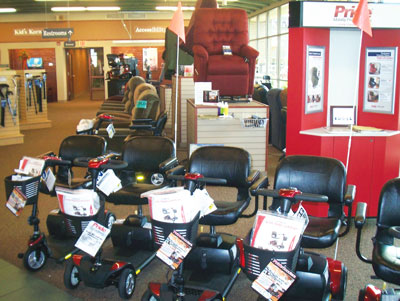
“The technicians are the ones who actually fabricate the devices. They are highly trained professionals who use their talents to fabricate the product that has been determined by the practitioner as being the most appropriate.”
Collaborative Care
Not everyone needs a prosthesis, of course. In fact, HealthCare Accessories is seeing more and more customers who need a device for back, knee or other joint pain. That’s a reflection of American life: In a study presented in February to the American Academy of Orthopaedic Surgeons, for example, researchers found that the number of knee replacements grew to 600,000 in 2009 alone, twice the number in the past decade. Meanwhile, the American Chiropractic Association reported that half of all working Americans reported back pain.
“We have some walk-in traffic for softgoods, but our number-one source is our referral network,” Nylander says. “They know they can send patients here and they can get what they’re looking for.”
He says the normal process involves the patient going to see his or her doctor with, say, a sore or swollen knee. The physician sends the person to HealthCare Accessories with a prescription and a clinician—one of the company’s 12 practitioners, nine of whom are board certified with the others in various stages of training—conducts an assessment to determine the best product to fit the need. If the physician agrees with the clinician’s recommendation, a specific prescription is written and the product provided.
Nylander says he has seen a lot of changes in the O&P and orthopedic softgoods market over the years. “The biggest change is the advancement of technology. For prosthetics, this includes advances in energy-storing feet, computer-controlled knees and more-comfortable socket design and suspension. Also, lightweight components allow the wearer to use the product with less energy. For orthotics this includes new materials such as carbon fiber for superior strength and computer-controlled joints.”
Compression garments have changed for the better, too. “They used to be made of very dense, heavy fabric,” he says, “and now they are much lighter, more airy and much more comfortable.”
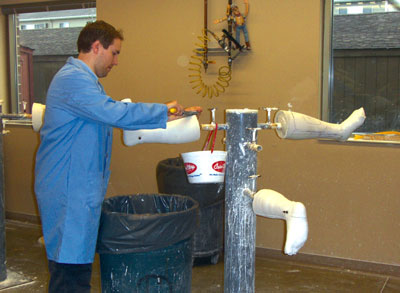
Nylander is particularly excited about the advancement of hand-held scanners, products that HealthCare Accessories recently purchased. “In the past work was initiated by casting body parts and building devices for that part. Now many practices are using digital scanners to replace the casting process. The scanner also provides an electronic record of the part and can be used to prove change in volume for future devices.”
All of this adds up to successfully providing the improved quality of life that has driven Healthcare Accessories since its earliest days.
The Medicare Conundrum
The fly in the ointment, however, is Medicare and Medicaid. In most O&P cases—as well as for many other products—HealthCare Accessories bills one or the other government agency or an insurance company for the products. Nylander believes it isn’t healthy for a business to rely too much on either.
“A huge consideration is how much business we do with Medicare and Medicaid. Just five years ago, 30 percent of our revenue was derived from these two sources,” he says. “Now that percentage is down to 24 percent, and hopefully going lower. A provider cannot survive on the reimbursement levels from these two and must find alternative sources of revenue to stay in business.”
O&P is not his main concern when it comes to government reimbursement. “Medicare’s competitive bidding has not affected the O&P industry as yet. Frankly, I doubt it will have much of an impact, as most of the products are so individualized to the customer that it is impossible to standardize them,” Nylander says. “Each custom orthosis or prosthesis is fabricated specifically to a person’s body, needs and lifestyle and can’t be used on anyone else.”
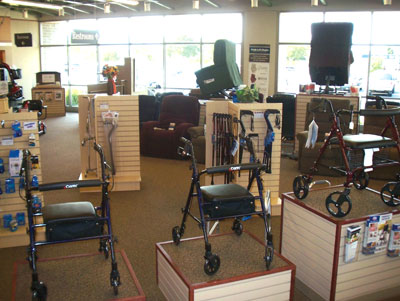
Still, many of HealthCare Accessories’ other products fall under competitive bidding. While it may not formally encompass much of his service area because it is rural, it will nevertheless have an impact on the business eventually. Nylander is therefore keen on reducing his company’s dependence on government reimbursement.
Smart Strategies
Building the company’s retail business might be part of the answer. Nylander says that segment has been growing—and, of course, that includes sales of a lot of basic orthopedic softgoods.
While HealthCare Accessories already does a brisk walk-in business, Nylander is always seeking ways to get the word out about the company and further build that segment. Toward that end, on a recent June day HealthCare Accessories hosted its annual Customer Appreciation Day. Some 400 people braved a bit of rain to munch on hotdogs, chips and beans and wander the huge showroom to see what was new. The company got a big boost from the local radio station, which aired a live broadcast from the location.
“We do a little bit of newspaper advertising, but radio is number one,” Nylander says. “We have one of the highest-rated AM stations in the country, and it’s based here in Fargo. They do a wonderful job for us, they’re very effective.”
He’s not banking on retail alone to keep the company going, however. “We have a person whose job is staying abreast of any and all changes in the industry,” he says. “She has given us a head’s up on a lot of things before they hit. In most cases, if we have advance notice we can prepare.”
For example, when rumbles began to be detected about a possible 36-month oxygen cap some years back “we started to prepare,” Nylander says, noting that staff worked to identify ways to manage costs during a time of little to no income.
The company also works on the Lean business model that the car manufacturer Toyota developed, in which the basic focus is on customer value and everything the organization does must enhance that. Nylander is a big believer. “Providers really need to adopt the Lean methodology. A few years ago our entire health system adopted it, and it has provided us with ways to greatly affect our costs in a positive manner—whether it’s how we process a purchase order, or how we handle our claim processing.”
He has also found tremendous advantage in going to electronic customer records. “We adopted this three years ago, and it is amazing to walk around and note the lack of paper on people’s desks. Claims processors have access to everything they need to do their job and get the claims paid faster. Each claim processor has a ‘four in one’ printer at their station, so there’s no need to leave to use a scanner, copier, printer or fax. It’s just amazing what that has done for our efficiencies.”
A Matter of Trust
Streamlining business operations, embracing retail sales, identifying new sources of revenue and deepening relationships with customers are just a few of the approaches HME providers should adopt to weather the storm the industry is currently facing, according to Nylander.
“We cannot be so dependent on these government payers,” he says. “You can’t trust them, and you don’t know where it’s going. We are definitely pursuing every item of alternate revenue we can find. We’ll still be there, but we cannot rely on reimbursement levels. We just don’t know where they’re headed.”
Health Tips for HME Providers
Russ Nylander, president of Sanford Health HealthCare Accessories (www.healthcareaccessories.com), is well aware that the home medical equipment (HME) industry has changed dramatically since he first entered it 26 years ago.
There’s little doubt that government red tape, increased regulation and decreased reimbursement can be hazardous to an HME provider’s health, but he believes there are some things providers can do to enhance their staying power. Here are his suggestions:
- Listen to your customers, referral sources and staff. “They have great ideas,” he says, noting that in developing its emergency plan for customers, Healthcare Accessories staff talked with a continuous ventilator patient about what happened to his access during an emergency. That has become the basis of the company’s plan.
- Keep a close eye on costs. They can get out of hand in a hurry.
- Hire good people who are passionate about helping others.
- Provide your staff with the best training available. Invest in them, and they will reward you.
- Stay abreast of industry changes. You must be able to foresee and react quickly to changes in reimbursement, regulations and other requirements.
